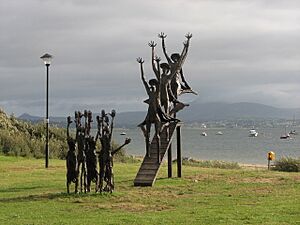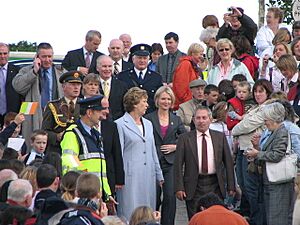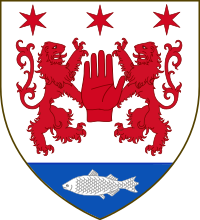Flight of the Earls facts for kids
The Flight of the Earls (Irish: Imeacht na nIarlaí) happened in September 1607. It was when two important Irish leaders, Hugh O'Neill and Rory O'Donnell, left Ulster, Ireland. They sailed to mainland Europe with about ninety followers. Their departure was a huge moment in Irish history. It marked the end of the old way of life for the Gaelic Irish chiefs.
Contents
What was the Flight of the Earls?

This event was first called a "flight" in a book from 1868. Historians still discuss why the earls left. Some think they wanted to start a war with help from Spain. They hoped to get their power back. Others believe they chose exile because they had lost much of their status. This loss happened after the Treaty of Mellifont in 1603.
Why did the Earls leave Ireland?

After a big defeat at the Battle of Kinsale in 1601, Hugh Roe O'Donnell went to Spain. He wanted help from King Philip III. He died there, and his brother Rory O'Donnell took his place.
Even though they lost, the O'Neills and O'Donnells kept their lands and titles. But their power was much smaller. The countryside was also ruined by fighting, leading to a famine in 1603. Hugh O'Neill, Earl of Tyrone was pardoned in 1603 and agreed to obey the English Crown.
When King James I became king in 1603, he pardoned many Irish lords. He understood how to work with local chiefs. However, O'Neill lost a lot of land to his relatives and neighbors. These lands were given to them under the English system. This was part of the long-term plan of the Tudor conquest of Ireland.
In 1605, the new English leader in Ireland, Sir Arthur Chichester, started to limit the earls' freedoms. He gave land to chiefs like O'Cahan, who used to be under O'Neill's rule. Chichester wanted to weaken O'Neill's power. O'Cahan also wanted to be free from O'Neill.
The discovery of the Gunpowder Plot in England made things harder for Catholics. It was difficult for them to show loyalty to both the king and the Pope. By 1607, O'Neill's friends, the Maguires and the Earl of Tyrconnell, were struggling. They had less money and prestige.
They planned to get help from Spain. O'Neill seems to have joined them suddenly when their ship arrived. He had three choices:
- Run away with his friends and hope Spain would invade Ireland.
- Go to London and try to fix his problems with the king.
- Stay in Ulster with less power and money.
They chose to flee to Continental Europe. They hoped to gather an army there with Spanish help. But Spain's main fleet had been defeated in the Battle of Gibraltar earlier in 1607. Also, the war between England and Spain had ended in 1604. King Philip III of Spain wanted peace with England. Spain was also in debt. Tyrone did not accept these facts and kept hoping for an invasion until he died in 1616.
The End of the Old Gaelic Order
The earls left from Rathmullan, a town on Lough Swilly. They sailed on a French ship with many other important Gaelic families. Their departure meant the end of the old Gaelic way of life. The earls came from Gaelic families who had ruled parts of Ulster for centuries.
This event was a turning point in Irish history. The old aristocracy of Ulster went into permanent exile. Even though they were important in the Gaelic system, the earls' ancestors had accepted their titles from the English in the 1540s. This was part of a policy called surrender and regrant.
Some historians say their flight was forced by the English conquest. Others say it was a big mistake that allowed the Plantation of Ulster to happen. The Plantation was when many English, Welsh, and Scottish settlers moved to Ulster.
The Journey to Europe
The Earls sailed from Rathmullan with about ninety followers. Many were noblemen from Ulster, and some brought family members. Several left their wives behind, hoping to return or get them later.
According to a historical account, the Earl of Tyrone had a gold cross with a piece of the True Cross. He put it in the water behind the ship during a storm. This supposedly helped calm the storm. They reached Quillebeuf-sur-Seine in Normandy, France, on October 4, 1607.
Their goal was Spain, but they landed in France. The group traveled by land to Spanish Flanders. Some stayed in Leuven, while the main group went on to Italy. Tadhg Ó Cianáin wrote a detailed diary about their journey. He mentioned that they were welcomed by many officials. But he did not write about any plans for a new war with Spain to get their lands back.
Ó Cianáin's diary is very important. It is the only continuous account of the Flight written at that time.
Loss of Titles and Lands
King James I announced on November 15, 1607, that the earls' actions were treason. This meant their lands and titles could be taken away. Their titles were officially taken away in 1614. However, they were still recognized as earls in Catholic countries in Europe.
These actions had a huge impact on the people of Ulster. The peace agreement from 1603 was broken because the lords left without permission. Their remaining lands were taken by the Crown. Sir Arthur Chichester then suggested bringing new settlers from England, Wales, and Scotland to Ulster. This plan was called the Plantation of Ulster. It greatly changed the lives of the Gaelic people living there.
Spanish Policy Changes
In 1555, the Pope had given the title King of Ireland to King Philip II of Spain. But Philip II did not claim this title after Queen Mary died in 1558. Spain had a long war with England and supported Irish rebels until 1601. O'Neill had offered the kingship to Spain in 1595, but Spain refused.
So, it made sense for O'Donnell and O'Neill to think Spain might help them. However, Spain's policy was to keep the peace with England after their treaty in 1604. Also, Spain's fleet had been weakened by other conflicts. By mid-1607, Spain did not want or have the means to help an Irish rebellion. The idea that the Flight was the first step in a new war is likely false. Spain had no plans to support the earls.
Remembering the Flight

In 2007, the 400th anniversary of the Flight of the Earls was celebrated. Events took place across Donegal, including boat races, fireworks, and talks. The President of Ireland, Mary McAleese, unveiled a statue in Rathmullan to remember the Flight.
There are also permanent exhibitions about the Flight of the Earls and the Plantation in Draperstown and at the "Flight of the Earls Centre" in Rathmullan. The Irish post office also released special stamps to mark the anniversary. In 2008, celebrations were held in Rome to mark the earls' arrival there.
See also
- Tudor conquest of Ireland
- Contention of the bards
- O'Cahan
- Tadhg Ó Cianáin
- "The Hunting of the Earl of Rone"
- Regiment of Hibernia




